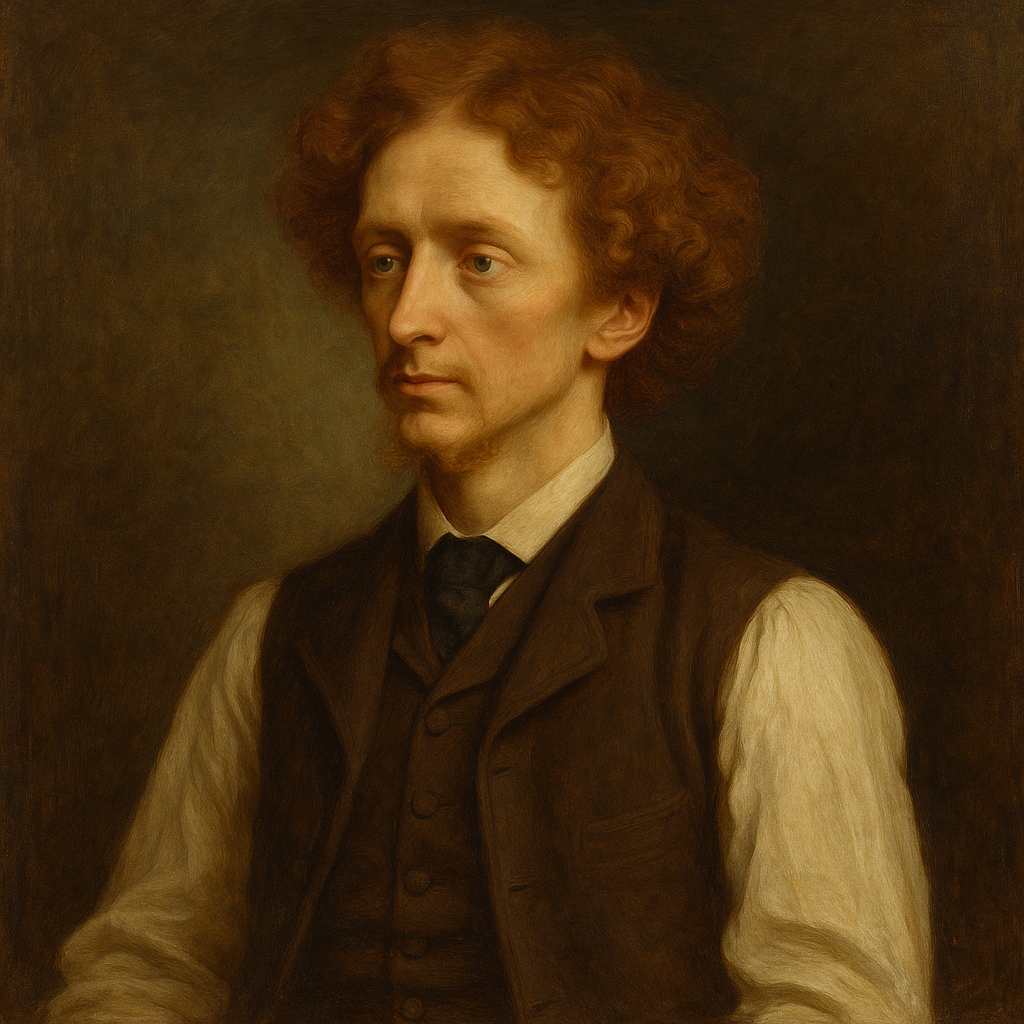Love laid his sleepless head
Algernon Charles Swinburne
1837 to 1909

Love laid his sleepless head
On a thorny rosy bed;
And his eyes with tears were red,
And pale his lips as the dead.
And fear and sorrow and scorn
Kept watch by his head forlorn,
Till the night was overworn
And the world was merry with morn.
And Joy came up with the day
And kissed Love's lips as he lay,
And the watchers ghostly and grey
Sped from his pillow away.
And his eyes as the dawn grew bright,
And his lips waxed ruddy as light:
Sorrow may reign for a night,
But day shall bring back delight.
Algernon Charles Swinburne's Love laid his sleepless head
Algernon Charles Swinburne (1837–1909) was a prominent English poet of the Victorian era, known for his mastery of rhythm, sensuous imagery, and exploration of themes such as love, pain, and transcendence. His work often reflects the aesthetic and decadent movements of the late 19th century, which emphasized beauty, emotional intensity, and the interplay of pleasure and suffering. "Love laid his sleepless head" is a quintessential example of Swinburne's ability to weave these elements into a compact yet profoundly evocative poem.
Historical and Cultural Context
To fully appreciate Swinburne's poem, it is essential to situate it within the broader cultural and literary milieu of the Victorian era. The 19th century was a period of profound social, political, and intellectual change, marked by industrialization, scientific advancements, and shifting moral values. In literature, this era saw the rise of Romanticism's emotional fervor and the subsequent transition to the more restrained and morally complex sensibilities of Victorianism. Swinburne, however, defied easy categorization. His work often straddled the line between Romantic exuberance and Decadent introspection, embracing themes of passion, suffering, and the ephemeral nature of human experience.
The poem "Love laid his sleepless head" can be read as a meditation on the dualities inherent in love: its capacity to bring both joy and pain, its vulnerability, and its resilience. These themes resonate with the Victorian fascination with emotional extremes and the tension between earthly suffering and spiritual redemption. Swinburne's use of classical and mythological imagery, such as personifying Love as a figure in distress, aligns with the Victorian penchant for allegory and symbolism.
Literary Devices and Imagery
Swinburne's poem is a masterclass in the use of literary devices to evoke emotion and create vivid imagery. The poem's structure is deceptively simple, consisting of four quatrains, but within this framework, Swinburne employs a range of techniques to heighten its impact.
-
Personification: The central device in the poem is the personification of Love as a vulnerable, almost human figure. Love is depicted as weary and sorrowful, with "sleepless head," "eyes with tears," and "pale lips." This anthropomorphism allows Swinburne to explore the emotional complexities of love in a tangible and relatable way. By giving Love a physical form, the poet invites readers to empathize with its suffering and eventual renewal.
-
Imagery: Swinburne's imagery is both lush and poignant. The "thorny rosy bed" on which Love rests is a powerful symbol of the paradoxical nature of love: it is both beautiful and painful, offering comfort and causing harm. The contrast between the "thorny" and "rosy" elements of the bed encapsulates the duality of love's experience. Similarly, the transition from night to day serves as a metaphor for the cyclical nature of emotional states, with sorrow giving way to joy.
-
Symbolism: The poem is rich in symbolic meaning. The "thorny rosy bed" evokes the crown of thorns associated with Christ's suffering, suggesting a sacrificial dimension to Love's ordeal. The "watchers ghostly and grey"—fear, sorrow, and scorn—represent the negative emotions that often accompany love, particularly in its unfulfilled or troubled states. Their departure at dawn symbolizes the triumph of joy and hope over despair.
-
Contrast and Juxtaposition: Swinburne frequently employs contrast to underscore the poem's themes. The darkness of night, with its attendant sorrow and fear, is juxtaposed with the brightness of dawn, which brings joy and renewal. Similarly, Love's initial state of pallor and tears is contrasted with the later imagery of "ruddy" lips and bright eyes, emphasizing the transformative power of time and hope.
-
Sound and Rhythm: While the poem does not adhere to a strict rhyme scheme, Swinburne's use of alliteration and assonance creates a musical quality that enhances its emotional resonance. Phrases like "sleepless head," "thorny rosy bed," and "watchers ghostly and grey" demonstrate his skill in using sound to reinforce meaning and mood.
Themes
The poem explores several interconnected themes, each contributing to its overall emotional and philosophical depth.
-
The Duality of Love: At its core, the poem is a meditation on the dual nature of love. Love is portrayed as both a source of profound suffering and a wellspring of joy. The "thorny rosy bed" symbolizes this duality, suggesting that love's beauty is inseparable from its capacity to cause pain. Swinburne does not shy away from depicting love's vulnerability, but he also emphasizes its resilience and capacity for renewal.
-
The Cyclical Nature of Emotion: The poem's structure mirrors its thematic focus on cycles and transitions. The progression from night to day reflects the natural rhythm of life, in which periods of darkness and sorrow are inevitably followed by light and joy. This cyclical view of emotion aligns with Swinburne's broader philosophical outlook, which often emphasizes the transient and ephemeral nature of human experience.
-
The Triumph of Joy Over Sorrow: While the poem acknowledges the reality of suffering, it ultimately celebrates the triumph of joy. The arrival of Joy at dawn, with its tender gesture of kissing Love's lips, symbolizes the restorative power of hope and happiness. The departure of the "watchers ghostly and grey" further underscores this theme, suggesting that negative emotions are temporary and can be overcome.
-
The Vulnerability of Love: By personifying Love as a figure in distress, Swinburne highlights its vulnerability. Love's sleeplessness, tears, and pallor suggest a state of emotional exhaustion, perhaps reflecting the poet's own experiences or observations of love's challenges. This vulnerability, however, is not portrayed as a weakness but as an inherent aspect of love's depth and intensity.
Emotional Impact
One of the most striking aspects of Swinburne's poem is its ability to evoke a profound emotional response. The imagery of Love's suffering is deeply moving, inviting readers to reflect on their own experiences of love's trials and tribulations. At the same time, the poem's hopeful conclusion offers a sense of catharsis, reminding readers that joy and renewal are always possible, even after the darkest nights.
The emotional impact of the poem is further enhanced by its universality. While Swinburne's language and imagery are rooted in the aesthetic and cultural sensibilities of the Victorian era, the themes he explores—love, suffering, hope, and renewal—are timeless. This universality allows the poem to resonate with readers across different historical and cultural contexts.
Conclusion
"Love laid his sleepless head" is a testament to Algernon Charles Swinburne's skill as a poet and his ability to capture the complexities of human emotion in a few carefully chosen words. Through its rich imagery, evocative symbolism, and exploration of universal themes, the poem offers a poignant meditation on the dualities of love and the cyclical nature of emotional experience. It is a work that invites repeated reading and reflection, revealing new layers of meaning with each encounter.
In the broader context of Swinburne's oeuvre, this poem exemplifies his commitment to exploring the interplay of beauty and suffering, a theme that resonates throughout his work. It also reflects the Victorian fascination with emotional extremes and the search for meaning in a rapidly changing world. Ultimately, "Love laid his sleepless head" stands as a timeless reminder of love's vulnerability, resilience, and transformative power—a message that continues to resonate with readers today.
This text was generated by AI and is for reference only. Learn more
Want to join the discussion? Reopen or create a unique username to comment. No personal details required!



Comments
No comments yet. Be the first to comment!